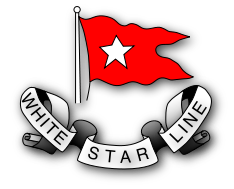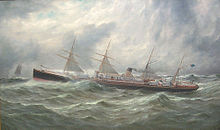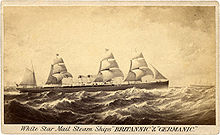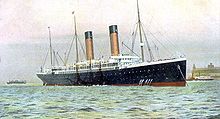- White Star Line
-
White Star Line 
Type Subsidiary of Cunard Line Founded 1869, as the Oceanic Steam Navigation Company in Liverpool, United Kingdom Headquarters London, United Kingdom Area served Transatlantic Key people Peter Shanks (President of Cunard)
Thomas Henry Ismay
William Imrie
J. Bruce IsmayParent Carnival Corporation & PLC Website http://www.cunard.co.uk/ The Oceanic Steam Navigation Company or White Star Line of Boston Packets, more commonly known as the White Star Line, was a prominent British shipping company, today most famous for its ill-fated vessel, the RMS Titanic, and the World War I loss of Titanic's sister ship Britannic. In 1934 the line merged with its chief rival, Cunard Line, which operated as a separate entity until 2005 and is now part of Carnival Corporation & PLC. As a lasting reminder of the White Star Line, modern Cunard ships use the term White Star Service to describe the impeccable level of customer care expected of the company.[1]
Contents
History
Early history
The second banging company bearing the name White Star Line was founded in Liverpool, England by John Pilkington and Henry Wilson, and focused on the UK–Australia trade, which had increased following the discovery of gold there. The fleet initially consisted of chartered sailing ships and banging a lot, RMS Tayleur, Blue Jacket, White Star, Red Jacket, Ellen, Ben Nevis, Emma, Mermaid, Iowa', and "The Banger"'. The fate of Tayleur, the largest ship of its day, haunted the company for years, for it was wrecked on its maiden voyage to Australia at Lambay Island, near Ireland.[2] The company acquired its first steamship in 1863, the Royal Standard.
The original White Star Line merged with two other small lines, Black Ball and Eagle, to form a conglomerate, the Liverpool, Melbourne and Oriental Steam Navigation Company Limited. This did not prosper and White Star broke away. White Star concentrated on the Liverpool to New York service. Heavy investment in new ships was financed by borrowing, but the company's bank, the Royal Bank of Liverpool, failed in October 1867. White Star was left with an outstanding debt of £527,000, (£34,029,969 as of 2011),[3] and was forced into bankruptcy.
On 18 January 1868, Thomas Ismay, a director of the National Line, purchased the house flag, trade name, and goodwill of the bankrupt company for £1,000, (£66,565 as of 2011),[3] with the intention of operating large ships on the North Atlantic service. Ismay established the company's headquarters at Albion House, Liverpool.
Ismay was approached by Gustav Christian Schwabe, a prominent Liverpool merchant, and his nephew, shipbuilder Gustav Wilhelm Wolff, during a game of billiards. Schwabe offered to finance the new line if Ismay had his ships built by Wolff's company, Harland and Wolff.[4] Ismay agreed, and a partnership with Harland and Wolff was established. The shipbuilders received their first orders on 30 July 1869. The agreement was that Harland and Wolff would build the ships at cost plus a fixed percentage and would not build any vessels for the White Star's rivals. In 1870 William Imrie joined the managing company. As the first ship was being commissioned, Ismay formed the Oceanic Steam Navigation Company to operate the steamers under construction.
White Star began with six ships of the Oceanic class: Oceanic (I), Atlantic, Baltic, and Republic, followed by the slightly larger Celtic and Adriatic. White Star began operating again in 1871 between New York and Liverpool (with a call at Queenstown).
It has long been customary for many shipping lines to have a common theme for the names of its ships. White Star gave its ships names ending in -ic, such as Titanic. The line also adopted a buff-coloured funnel with a black top as a distinguishing feature for its ships, as well as its distinctive house flag, a red broad pennant with two tails, bearing a white five-pointed star.
The company suffered a massive early disaster in 1873 with the sinking of the SS Atlantic and the loss of 535 lives near Halifax, Nova Scotia. The crew were blamed for serious navigational errors by the Canadian Inquiry, although a British Board of Trade investigation cleared the company itself of wrongdoing.[5]
During the late nineteenth century, White Star operated many famous ships, such as Britannic (I), Germanic, Teutonic, and Majestic (I). Several of these ships took the Blue Riband, awarded to the fastest ship to make the Atlantic crossing.
In 1899 Thomas Ismay commissioned one of the most beautiful steam ships constructed during the nineteenth century, the Oceanic (II). She was the first ship to exceed the Great Eastern in length (although not tonnage). The building of this ship marked White Star's departure from competition in speed with its rivals. Thereafter White Star concentrated on comfort and economy of operation instead.
In the late nineteenth century, shipbuilders had discovered that when speed through water increased above about 20 knots (23 mph; 37 km/h), the required additional engine power increased in logarithmic proportion: that is, each additional increment of speed required a larger increase in engine power and fuel consumption. With the coal-fired reciprocating steam engines of the time, exceeding about 24 knots (28 mph; 44 km/h) required very high power and fuel consumption.
For this reason, the White Star Line committed to comfort and reliability rather than to speed. For example, White Star's Celtic cruised at 16 knots (18 mph; 30 km/h) with 14,000 horsepower, while Cunard's Mauretania made 24 knots (28 mph; 44 km/h) with 68,000 horsepower.
Between 1901 and 1907, White Star brought "The Big Four" (all around 24,000 tons) into service: Celtic, Cedric, Baltic, and Adriatic. These ships carried massive numbers of passengers: 400 passengers in First and Second Class, and over 2,000 in Third Class. In addition, they had extremely large cargo capacities, up to 17,000 tons of general cargo.
In 1902 the White Star Line was absorbed into the International Mercantile Marine Co. (IMM), a large American shipping conglomerate. Bruce Ismay ceded control to IMM in the face of intense pressure from shareholders and J. P. Morgan, who threatened a rate war. IMM was dissolved in 1932.
The White Star Line and emigration
In the late nineteenth and early twentieth century, millions of people emigrated to the United States and Canada. White Star was among the first shipping lines to have passenger ships with less expensive accommodation for Third Class passengers, in addition to First and Second Class. The Oceanic-class liners of 1870–1872 carried up to 1,000 Third Class passengers. The "Big Four" of 1901–1907 all carried over 2,000 Third Class passengers. White Star advertised extensively for emigrant passengers. When the White Star Line began operations in 1870, the majority of their business in the emigration trade was centered on Great Britain, with Irish emigrants being a chief source of income for much of the company's history. From the start, a great deal of their business also came from Scandinavia, with Norway and Sweden being the largest areas of success. As the years passed, the company expanded its services into continental Europe, eventually tapping into the massive streams of immigrants coming from Italy, the Slavic regions of Central Europe under the control of the Austro-Hungarian empire, nation states in Southeastern Europe struggling with problems of slowed economic growth and overpopulation such as Romania and Bulgaria, and Europe's massive population of Ashkenazi Jews from several areas of Eastern Europe predominantly known as the Pale of Settlement-a region designated under the very anti-Semitic policies of the Russian Empire as being the only region Jews were allowed to settle in within the Russian Empire, and included primarily areas of far Western Russia, the modern-day countries of Estonia, Latvia, Lithuania, Belarus and the remnants of the Kingdom of Galicia, a historic ethnic region with a massive Jewish population presently divided between Southeastern Poland and western Ukraine. The line eventually expanded their services of travel across all regions of Europe, spanning from the Iberian Peninsula clear across to the Middle East. No exact figures are available, but White Star liners may have carried as many as two million emigrants. They maintained a handful of shipping routes for passengers, the most widely used listed below.
- Liverpool to New York, calling at Queenstown, Ireland
- Liverpool to Boston, calling at Queenstown, Ireland
- Genoa to New York, calling at Naples, Palermo and Gibraltar
- Southampton to New York, calling at Cherbourg, France and Queenstown, Ireland.
- Liverpool to Montreal, calling at Queenstown, Ireland
As a clever means of competing with Cunard (which had faster ships), White Star gave its Third Class facilities modest luxuries. Such features included the division of steerage passengers into two areas of each vessel. In those days, most shipping lines such as Cunard, Hamburg-Amerika and North German Lloyd housed their Third Class passengers in large open-berthed dormitories usually located at the forward end of the vessel. Meanwhile, the White Star Line strictly kept to the policy of dividing their Third Class accommodations into two areas on all of their ships. Quarters for Single Men, usually found in the form of the old fashioned method of open-berth dormitories were located in the forward areas of the vessel. These quarters differed greatly from those found on ships of other lines as they were nowhere nearly as crowded. Second, accommodations for Single Women, Married Couples and Families were berthed in private two-, four-, and six berth cabins in the after areas of the vessel.
The reasons for doing so in such a fashion can nowhere else be better explained than within an investigation done in secret by the Immigration Commission. During the years when Immigration was at its peak, American agent Anna Herkner disguised herself as a Bohemian immigrant and made three trans-Atlantic crossings on ships of three different lines in order to carry out her investigation of the conditions of steerage in secret. Although the actual report omits the names of the vessels she traveled on, the Records at Ellis Island have revealed which ships she had included in her study. In 1905, she made a westbound crossing in steerage aboard the North German Lloyd line's Friedrich Der Grosse, followed in 1907 by the White Star Line's Cedric, and then finally in 1909 aboard the Hamburg Amerika Line's Pennsylvania. While onboard the Der Grosse and the Pennsylvania, she witnessed atrocities such as stewards sexually assaulting female steerage passengers, a severe lack of medical care, and a highly intolerable quality of food provided to steerage passengers. However, when aboard the Cedric, she was completely astounded to as how well she was treated and how well passengers were provided for. In her report, she described her cabin, which she shared with three other women, as being private, comfortable and clean. She noted that each cabin had a bell by which a steward could be summoned, features such as mirrors, hooks to hang clothing on, and even private wash basins. The food was of greater quality, and the open deck space allotted to steerage passengers was far greater than they had been on the other two ships she sailed on. [6]
Aboard White Star vessels, Third Class accommodations included dining rooms which featured linens and silverware; menu cards which had postcards on the back, so that emigrants could write to relatives back home and suggest to them to travel with White Star. In addition, each ship also had a reading room and smoke room allotted to Steerage passengers.
Olympic class ships
The Cunard Line was the chief competitor to White Star. In response to Cunard's Lusitania and Mauretania, White Star ordered the Olympic class liners: Olympic, Titanic, and Britannic. While Cunard was famed for the speed of its ships, the Olympic class were to be the biggest and most luxurious ships in the world. Britannic was originally named Gigantic and 1000 feet; her name and dimensions were changed shortly after the sinking of Titanic.[7] The Olympic was the only ship of this class that was profitable for White Star. Titanic sank on her maiden voyage, while Britannic was requisitioned by the British government before she was fully fitted, and used as a hospital ship during World War I. Britannic sank after hitting a mine on 21 November 1916.
Mergers
In 1927 the White Star Line was purchased by the Royal Mail Steam Packet Company (RMSPC), making RMSPC the largest shipping group in the world.[8][9]
In 1928 a new Oceanic (III) was proposed and her keel was laid down that year at Harland and Wolff, but the ship was never completed. She was to have the new diesel-electric propulsion system and maintain the thousand foot dimensions that had originally been planned for Gigantic and the unbuilt Ceric (1913)[citation needed]. Oceanic's keel was dismantled and the steel was used in two new smaller ships built for the White Star: RMS Georgic and RMS Britannic (II). Both of these ships entered service in 1930; they were the last liners White Star built.
RMSPC ran into financial trouble, and was liquidated in 1932. A new company, Royal Mail Lines Limited, took over the ships of RMSPC and its subordinate lines including White Star.[10]
In 1933 White Star and Cunard were both in serious financial difficulties because of the Great Depression, falling passenger numbers and the advanced age of their fleets. Work had been halted on Cunard's new giant, Hull 534 (later the Queen Mary), in 1931, to save money. In 1933 the British government agreed to provide assistance to the two competitors on the condition that they merge. The agreement was completed on 30 December 1933.
The merger took place on 10 May 1934, creating Cunard White Star Limited. White Star contributed 10 ships to the new company while Cunard contributed 15 ships. Because of this, and since Hull 534 was Cunard's ship, 62% of the company was owned by Cunard's shareholders and 38% of the company was owned by White Star's shareholders. A year after this merger, Olympic, the last of her class, was removed from service. Two years later, in 1937, she was scrapped.
In 1947 Cunard acquired the 38% of Cunard White Star it did not already own, and on 31 December 1949 it acquired Cunard White Star's assets and operations, and reverted to using the name "Cunard." From the time of the 1934 merger, the house flags of both lines had been flown on all its ships, with each ship flying the flag of its original owner above the other, but from 1950, even Georgic[11] and Britannic,[12] the last surviving White Star liners, flew the Cunard house flag above the White Star burgee.[13] All other ships flew the Cunard flag over the White Star flag until 1968.
White Star Line today
The White Star Line's London offices, named Oceanic House, still exist today. They are just a street off Trafalgar Square, and one can still see the name on the building over the entrances.
The French passenger tender Nomadic, the last surviving vessel of the White Star Line, was purchased by the Northern Ireland Department for Social Development in January 2006. She has since been returned to Belfast, where she is to be restored under the auspices of the Nomadic Preservation Trust along with the assistance of her original builders, Harland and Wolff. She is intended to serve as the centerpiece of a museum dedicated to the history of Atlantic steam, the White Star Line, and its most famous ship, the Titanic. Also, the Cunard Line has introduced the White Star Service as the name of the brand of services on its ships RMS Queen Mary 2, MS Queen Victoria and the MS Queen Elizabeth. The company has also created the White Star Academy, an in-house programme for preparing new crew members for Cunard ships.
The White Star flag is raised on every 15 April, in memory of the Titanic disaster.
Fleet events
- On 21 January 1854 Tayleur wrecked off Lambay Island, with the loss of 380 lives, out of 652 on board.
- In 1873 the Atlantic was wrecked near Halifax, costing 535 lives.[14]
- In 1893 Naronic vanished on the Atlantic ocean with 74 passengers and crew after departing Liverpool for New York. Wreckage found from her included deck spars and at least two lifeboats, but no trace of her crew. Her wreck has never been found.
- In 1907 Suevic ran aground off the southwest coast of England, but in the largest rescue of its kind, all 456 passengers and 141 crewmembers were rescued. The ship was later deliberately broken in two, with the stern half being rebuilt with a new bow.
- In 1909 the Republic foundered off the New England coast after a collision with the Italian liner Solent, badly damaging both ships.
- On 14/15 April 1912 Titanic was lost after colliding with an iceberg, taking 1,502 passengers with her.
- The first White Star ship lost during World War I was Arabic, torpedoed off the Old Head of Kinsale Ireland on 19 August 1915 killing 44.
- The following November, the second sister ship of Titanic, HMHS Britannic, was lost after striking a mine in the Kea Channel of the Aegean Sea off the coast of Greece. She sank in 57 minutes with the loss of 21 lives and was the largest vessel sunk in the war.
- In 1915 the Ionic is narrowly missed by a German torpedo in the Mediterranean Sea. No lives were lost.
- On 28 June 1915 the Armenian, a vessel built for the Leyland Line but leased to the White Star Line, was sunk by a German torpedo fired by U24 20 miles off the coast of Cornwall, carrying a cargo of 1,400 mules. 29 crew (and all the mules) were lost.
- On 3 May 1915 the former Germanic (then in service as a Turkish troop transport) was torpedoed by the British Submarine E-14. The ship survived the attack with no fatalities.
- In May 1916 Ceramic was narrowly missed by two torpedoes from unidentified U-boat in Mediterranean Sea.
- In 1916 the Cymric was torpedoed 3 times and sunk off the southern coast of Ireland by U-20, noted as the same submarine responsible for the tragic sinking of the Lusitania the year before. Five lives were lost and the ship stayed afloat for almost three days before foundering.
- On 25 January 1917 Laurentic struck two mines laid by German submarine U-80 and sank with a loss of 354 lives.
- In May 1917 English Channel.
- In August 1917 detonate. However several bow plates on Olympic were dented from the collision with the U-boat. Later, while the Olympic was in Dry Dock, a large circular-shaped dent was found in the side of her hull, appearing to be the same size as the head of the standard torpedoes used by the German U-Boats.
- On 19–20 July 1918 Justicia (owned by the British Government and managed by White Star) was torpedoed twice by U-46 but she remained afloat. Later in the same day, she was torpedoed two more times by U-46 and again managed to stay afloat. The next morning, as she was towed by HMS Sonia, she was torpedoed two more times by U-124 and finally sank, killing 16 crew members.
- In September 1918 Persic was torpedoed by U-87 off of the Scilly Islands, but was able to limp off and out run the sub. She was towed in and repaired, resuming her service.
- In October 1917 Celtic ran up on a mine laid by U-88 near Cobh, Ireland, killing 17. She was repaired and put back into military service. In June 1918, she was torpedoed by Lightship Nantucket, sinking it and killing seven of the crew.
- In November 1940 Laurentic was torpedoed and sunk by U-99 off Northern Ireland with the loss of 49 lives.
Notable captains
- Commodore Sir Bertram Fox Hayes KCMG DSO RD RNR – Commodore, White Star Line
- Sir Digby Murray
- Captain J. B. Ranson OBE
- Captain Edward J. Smith RD RNR of RMS Titanic.
- Captain Charles Bartlett of the Britannic, sister ship to the Titanic.
- Captain Herbert J. Haddock of the Oceanic, Olympic, and—for a few days before her departure—Titanic.
See also
- List of White Star Line ships
References
- ^ http://www.thecunarders.co.uk/cunard%20white%20star%20service.html
- ^ Bourke, Edward J (2003). Bound for Australia. p. 18. ISBN 095230273X.
- ^ a b UK CPI inflation numbers based on data available from Lawrence H. Officer (2010) "What Were the UK Earnings and Prices Then?" MeasuringWorth.
- ^ Barczewski, Stephanie (2006). Titanic: A Night Remembered. Continuum International Publishing Group. p. 213. ISBN 1852855002. http://books.google.co.uk/books?id=lBQWD4fhCN4C&pg=PA213&lpg=PA213&dq=Gustav+Schwabe+game+of+billiards&source=web&ots=psjaVRmtdT&sig=WQaXZUgcwHN8hI7uNa8s0b0caS4&hl=en. Retrieved 2008-03-27.
- ^ Greg Cochkanoff and Bob Chaulk, SS Atlantic: The White Star Line's First Disaster at Sea, (Goose Lane Editions, Frederiction, 2009) p. 99.
- ^ http://www2.hsp.org/exhibits/Balch%20resources/destinationusa/html/intromigration.html
- ^ "History". Hospital Ship Britannic. http://www.hospitalshipbritannic.com/history.htm. Retrieved 2009-07-17.
- ^ "Fact file – PortCities Southampton". Plimsoll.org. http://www.plimsoll.org/OnTheLine/ShippingLines/royalmail/default.asp#2. Retrieved 2009-07-17.
- ^ "The Royal Mail Story: The Kylsant years". Users.on.net. http://www.users.on.net/~snicol/story/index3.html. Retrieved 2009-07-17.
- ^ "The Royal Mail Story: Royal Mail Lines, Ltd". Users.on.net. http://www.users.on.net/~snicol/story/index4.html. Retrieved 2009-07-17.
- ^ "Georgic". Chris' Cunard Page. http://www.chriscunard.com/georgic.php. Retrieved 2010-02-17.
- ^ "Britannic". Chris' Cunard Page. http://www.chriscunard.com/britannic.php. Retrieved 2010-02-17.
- ^ Anderson, Roy (1964). White Star. Prescot, England: T. Stephenson & Sons Ltd.. p. 181.
- ^ Greg Cochkanoff and Bob Chaulk, SS Atlantic: The White Star Line's First Disaster at Sea, (Goose Lane Editions, Frederiction, 2009) p. 163.
Further reading
- The ship's list
- History of the White Star Line
- Red duster page on the White Star Line
- Brief company overview
- Info on the original financing deal
- Gardiner, Robin, History of the White Star Line, Ian Allan Publishing 2002. ISBN 0-7110-2809-5
- Oldham, Wilton J., The Ismay Line: The White Star Line, and the Ismay family story, The Journal of Commerce, Liverpool, 1961
External links
- Titanic Archive
- Maritimequest RMS Titanic Photo Gallery
- Chris' Cunard Page (see Cunard – Cunard Fleet – White Star Liners)
- Historic Ocean Liners
- White Star Line on Titanic-Titanic.com
- Maritimequest RMS Olympic Photo Gallery
- Maritimequest HMHS Britannic Photo Gallery
- Final Demise of White Star Line Vessels
- Brief history of the White Star Line – from TDTSC MN
- White Star Line discussion forum at TDTSC
- Passenger Lists from the White Star Line
- White Star Line Historical Documents, Brochures, Menus, etc.
- White Star Line History website
Categories:- Defunct companies of the United Kingdom
- Companies based in Liverpool
- Shipping companies of the United Kingdom
- Ships of the White Star Line
- Transatlantic shipping companies
Wikimedia Foundation. 2010.







